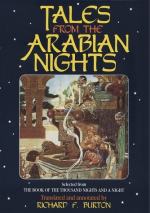squatting on the ground, tailor-fashion, like his
pupils, who may number from ten to thirty, repeats
the lesson in a sonorous singsong voice, and is imitated
by the urchins, who accompany their voices by a rocking
to and fro which sometimes enables them to keep time.
A sharp application of the cane is wonderfully effectual
in recalling wandering attention; and lazy boys are
speedily expelled. On the admission of a pupil,
the parents pay some small sum, varying according
to their means, and every Wednesday, which is a half-holiday,
a payment is made from 1/4d. to 2d. New moons
and feasts are made occasions for larger payments,
and are also holidays, which last ten days during
the two greater festivals. Thursdays are whole
holidays, and no work is done on Friday mornings,
that day being the Mohammedan ‘Sabbath,’
or at least ‘meeting day,’ as it is called.
When the pupils have mastered the first short chapter
of the Koran, it is customary for them to be paraded
round the town on horseback, with ear-splitting music,
and sometimes charitably disposed persons make small
presents to the youngster by way of encouragement.
After the first, the last is learned, then the last
but one, and so on, backwards, as, with the exception
of the first, the longest chapters are at the beginning.
Though reading and a little writing are taught, at
the same time, all the scholars do not arrive at the
pitch of perfection necessary to indite a polite letter,
so that consequently there is plenty of employment
for the numerous scribes or Talibs who make a profession
of writing. These may frequently be seen in small
rooms opening on to the street, usually very respectably
dressed in a white flowing haik and large turban,
and in most cases of venerable appearance, their noses
being adorned with huge goggles. Before them are
their appliances,—pens made of reeds, ink,
paper, and sand in lieu of blotting paper. They
usually possess also a knife and scissors, with a
case to hold them all. In writing, they place
the paper on the knee, or upon a pad of paper in the
left hand.” The main merit of the village
school in Eastern lands is its noises which teach
the boy to concentrate his attention. As Dr. Wilson
of Bombay said, the young idea is taught to shout
as well as to shoot, and this viva voce process is
a far better mnemonic than silent reading. Moreover
it is fine practice in the art of concentrating attention.
[FN#140] Arab. “Mikshat,” whose root would be “Kasht"=skinning (a camel).
[FN#141] Evidently said ironice as of innocents. In “The Forty Vezirs” we read, “At length they perceived that all this tumult arose from their trusting on this wise the words of children.” (Lady’s XXth Tale.)
[FN#142] Ms. iii. 219-220. For some unaccountable reason it is omitted by Scott (vi. 76), who has written English words in the margin of the W. M. Codex.
[FN#143] In text “Kadum,” for “Kudum,” a Syrian form.
[FN#144] Arab. “Hidyah,” which in Egypt means a falcon; see vol. iii. 138.




